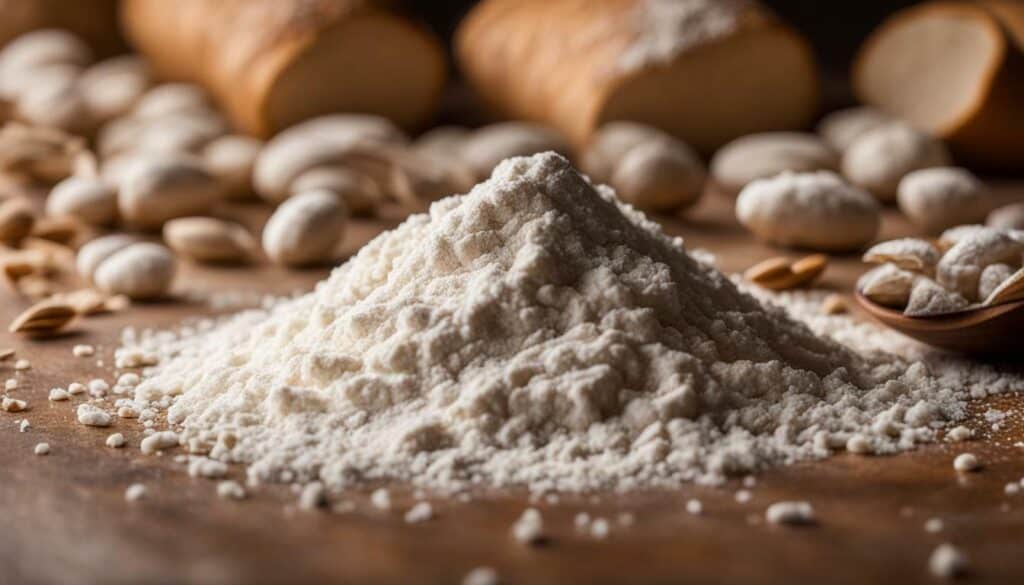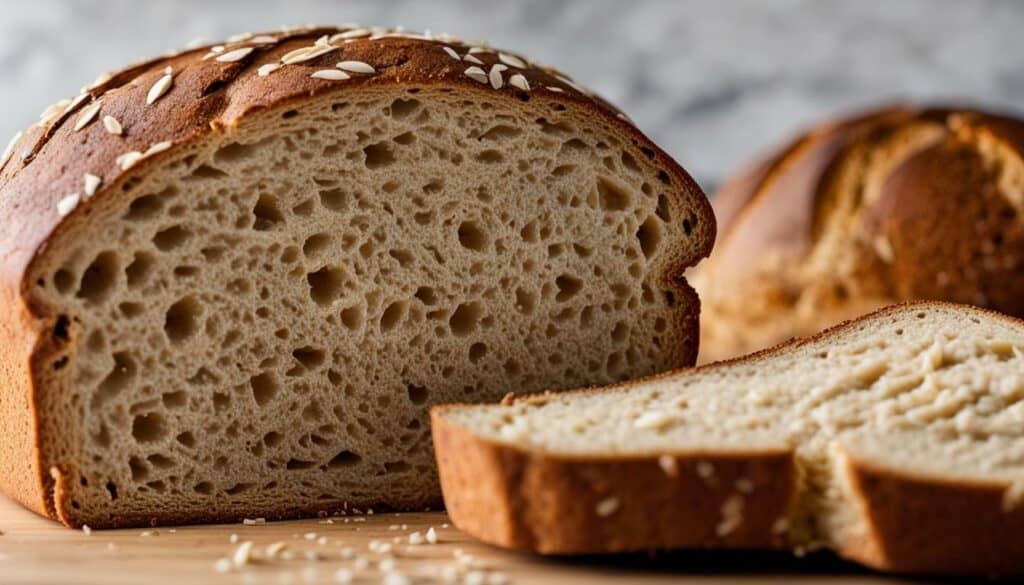When it comes to making bread, there are four main ingredients that come together to create the delicious loaves we all know and love. These ingredients are flour, yeast, water, and salt. Each ingredient plays a crucial role in the bread-making process, contributing to its texture, flavor, and overall quality.
Key Takeaways:
- Flour is the main ingredient that provides structure to the bread and forms gluten.
- Yeast is responsible for leavening the bread, creating carbon dioxide and steam through fermentation.
- Water helps form gluten bonds and acts as steam during baking.
- Salt enhances the flavor of the bread and moderates the yeast’s effect.
- Additional ingredients like fats, sugars, and liquids can be added for flavor and texture.
Now that you know the four main ingredients in bread, you can appreciate the science behind the art of bread-making. Stay tuned as we explore each ingredient in more depth and discover the variations and unique qualities of different types of bread.
The Four Key Ingredients in Bread
The foundation of bread lies in its four key ingredients: flour, yeast, water, and salt. Each ingredient plays a crucial role in the bread-making process, contributing to the texture, flavor, and overall quality of the final product.
Flour is the main component of bread, providing structure and giving the dough its characteristic elasticity. It contains proteins that, when mixed with water, form gluten. Gluten gives bread its chewy texture and helps it rise during baking. Different types of flour, such as all-purpose, whole wheat, or bread flour, can be used to achieve desired results.
Yeast, on the other hand, is responsible for leavening the bread. During fermentation, yeast consumes the sugar present in the dough and produces carbon dioxide and alcohol. The carbon dioxide creates air bubbles, giving the bread its light and airy texture. It’s important to use active yeast and ensure proper fermentation for the best results.
Water is not just a simple liquid in bread-making; it plays multiple roles. It hydrates the flour and activates the gluten-forming proteins. It also acts as a medium for yeast activity, allowing fermentation to occur. During baking, water in the dough turns into steam, contributing to crust formation and giving the bread a beautiful golden-brown color.
| Ingredient | Role |
|---|---|
| Flour | Provides structure and forms gluten |
| Yeast | Leavens the bread and creates carbon dioxide and steam through fermentation |
| Water | Helps form gluten bonds and acts as steam during baking |
| Salt | Enhances flavor and moderates the yeast’s effect |
Salt, although used in small amounts, is a vital ingredient. It not only adds flavor but also helps regulate yeast fermentation. Salt restricts the growth of yeast, allowing for controlled and extended fermentation. It also strengthens gluten, improves the texture, and acts as a natural preservative.
While these four ingredients form the foundation of any basic bread recipe, there are numerous variations and additional ingredients that can be incorporated to create different flavors, textures, and types of bread. From adding fats, sugars, and liquids to experimenting with whole wheat flour or sourdough starters, the possibilities are endless.
Now that you have a deeper understanding of the key ingredients in bread, why not try your hand at bread-making? Experiment with these essential ingredients, get creative with flavors, and enjoy the satisfaction of baking your own delicious loaf of bread.

Flour is the base ingredient that gives bread its structure and texture. It’s essential in bread-making, as it provides the foundation for a successful loaf. When combined with other ingredients and kneaded, flour forms the gluten network that gives bread its elasticity and chewiness.
Gluten, a complex protein, is formed when water is mixed with flour. This network of gluten strands acts as a scaffolding, trapping the gases produced by yeast during fermentation. It gives bread its airy and light texture.
To achieve the desired structure, different types of flour can be used. All-purpose flour, which is a blend of hard and soft wheat, is commonly used for everyday bread. It provides a balance between gluten development and tenderness. Bread flour, on the other hand, has a higher protein content, which results in a stronger gluten structure. This makes it ideal for artisan bread with a chewy texture and a crispy crust. Other types of flour, such as whole wheat flour or rye flour, can also be used to create bread with distinct flavors and textures.

| Type of Flour | Characteristics |
|---|---|
| All-Purpose Flour | Blend of hard and soft wheat, balanced gluten development |
| Bread Flour | Higher protein content, strong gluten structure |
| Whole Wheat Flour | Milled from the entire wheat kernel, adds nutty flavor and texture |
| Rye Flour | Produced from rye grains, imparts a distinct flavor and dense texture |
Understanding the role of flour and choosing the right type for your bread recipe is crucial for achieving the desired texture and flavor. Experimenting with different flours can lead to exciting variations and customized loaves that suit your taste preferences.
Yeast: The Leavening Agent
Yeast is responsible for the rise and airy texture of bread. When activated, it consumes sugar and produces carbon dioxide and alcohol through fermentation. This process creates bubbles in the dough, causing it to expand and become light and fluffy when baked. It’s truly magical how this tiny organism can transform a simple mixture of ingredients into a delightful loaf of bread.
Now, let’s explore the fascinating role of yeast in bread-making. The most commonly used type of yeast is known as Saccharomyces cerevisiae, which is available in both active dry and instant forms. Active dry yeast needs to be dissolved in warm water and activated before use, while instant yeast can be added directly to the dough without prior activation.
The fermentation process begins as soon as yeast comes into contact with warm water and sugar. It starts feeding on the sugar, multiplying and releasing carbon dioxide gas. This gas gets trapped in the dough, causing it to rise. The longer the fermentation time, the more complex and flavorful the bread becomes. So, don’t be afraid to let your dough rest and develop its flavors.
Yeast is a living organism, and its performance can be affected by various factors such as temperature, moisture, and the presence of salt. It’s important to follow the instructions carefully to achieve the desired results. So, let’s raise a toast to yeast, the secret ingredient that gives bread its marvelous rise!
Here’s a quick overview of yeast:
| Type | Activation | Usage |
|---|---|---|
| Active Dry Yeast | Dissolve in warm water and activate | Commonly used in traditional bread recipes |
| Instant Yeast | Can be added directly to the dough | Convenient and time-saving |

Yeast plays a crucial role in bread-making, transforming a simple mixture of ingredients into a delightful loaf of bread. It brings life to the dough, creating carbon dioxide and alcohol through fermentation. This process results in the airy texture and fluffy nature we all love in bread. So, next time you enjoy a slice of freshly baked bread, remember to thank the marvelous yeast for its magical contribution!
Water: The Gluten Bond and Steam Producer
Water not only hydrates the dough but also plays a crucial role in the bread-making process. Without water, flour cannot form gluten, which is essential for creating the structure and texture of bread. When water is combined with flour, a chemical reaction occurs that develops gluten, a network of proteins that gives bread its elasticity and ability to rise. This gluten network traps carbon dioxide produced by yeast, allowing the dough to expand and create airy pockets.
During baking, water in the dough turns into steam due to the high temperatures in the oven. This steam helps create a beautiful, golden crust on the outside of the bread while keeping the inside moist and tender. It also aids in the expansion of the bread, contributing to its light and airy texture.
Proper hydration is key when it comes to using water in bread-making. Different types of flour absorb water differently, so it’s important to adjust the amount of water accordingly to achieve the desired dough consistency. Too little water can result in a dense and dry loaf, while too much water can make the dough sticky and difficult to handle.
The Importance of Water in Bread-Making
To summarize, water serves multiple purposes in bread-making. It hydrates the dough, facilitates gluten formation, and acts as a steam producer during baking. The right amount of water, combined with the other main ingredients in bread—flour, yeast, and salt—leads to a well-balanced and delicious loaf. Next time you embark on a bread-making adventure, pay close attention to the role water plays and enjoy the rewarding process of creating your own homemade bread.
| Water in Bread-Making | Role |
|---|---|
| Hydration | Moistens the dough. |
| Gluten Formation | Allows the flour to form gluten, providing structure to the bread. |
| Steam Production | Creates steam during baking, contributing to crust development and texture. |
Salt: Flavor Enhancer and Yeast Moderator
Although often overlooked, salt plays an essential role in bread-making. Not only does it enhance the flavor of the bread, but it also serves as a yeast moderator, controlling the fermentation process. When added in the right amount, salt acts as a natural preservative, slowing down the growth of yeast and preventing the bread from rising too quickly.
Furthermore, salt is responsible for balancing the flavors in bread. It brings out the natural sweetness of the ingredients, making the bread taste more delicious. The addition of salt also helps to mask any unpleasant bitter flavors that may occur during the fermentation process.
When it comes to measuring salt for bread-making, it is crucial to follow the recipe carefully. Too little salt can result in a bland-tasting bread, while too much salt can hinder the fermentation process and make the bread overly salty. A general guideline is to add approximately 1 to 2 teaspoons of salt for every 500 grams of flour used in the recipe.
| Benefits of Salt in Bread-Making | Role of Salt in Bread-Making |
|---|---|
| Enhances flavor | Controls fermentation process |
| Acts as a natural preservative | Brings out sweetness of ingredients |
| Improves texture of bread | Mask unpleasant bitter flavors |
“Salt is like a secret ingredient that can take your homemade bread to the next level. Don’t underestimate its power!” – Baking enthusiast
So, the next time you embark on a bread-making adventure, remember the importance of salt. Not only does it enhance the flavor, but it also helps control the fermentation process, resulting in a perfectly balanced and delectable loaf of bread. Happy baking!

While the main ingredients are crucial, additional elements can elevate the taste and texture of bread. By incorporating fats, sugars, and liquids, bakers can create bread with enhanced flavor profiles and unique textures. Fats such as butter or olive oil add richness and moisture to the bread, resulting in a softer and more tender crumb. Sugars, such as honey or molasses, not only provide sweetness but also contribute to browning and crust formation. Liquids like milk or buttermilk can improve the dough’s texture and create a more tender loaf. These additional ingredients allow bakers to tailor the bread to their preferences and experiment with different flavors.
“Adding fats, sugars, and liquids to bread dough can transform a plain loaf into a delightful treat. The buttery flavor from the fats, the sweetness from the sugars, and the added moisture from the liquids make each bite a delicious experience.”
Some bakers may choose to incorporate other ingredients for specific variations of bread. Whole wheat bread, for example, uses whole wheat flour instead of refined white flour. This results in a nuttier flavor, denser texture, and higher nutritional value. Sourdough bread, on the other hand, relies on a mixture of wild yeast and lactobacilli for fermentation, which gives it a distinct tangy taste and a chewy crumb. These variations offer a wide range of flavors and textures, catering to different preferences and dietary needs.
Table: Common Additional Ingredients and Variations
| Ingredient/Variation | Description |
|---|---|
| Fats (e.g., butter, olive oil) | Add richness and moisture to the bread, resulting in a softer and more tender crumb. |
| Sugars (e.g., honey, molasses) | Provide sweetness, contribute to browning, and aid in crust formation. |
| Liquids (e.g., milk, buttermilk) | Improve texture and create a more tender loaf. |
| Whole Wheat Bread | Uses whole wheat flour for a nuttier flavor, denser texture, and higher nutritional value. |
| Sourdough Bread | Relies on wild yeast and lactobacilli for fermentation, resulting in a tangy taste and chewy crumb. |
Explore the possibilities by incorporating different fats, sugars, and liquids into your bread recipes. Let your creativity shine and enjoy the endless variations of bread that can be achieved with these additional ingredients.
Exploring Whole Wheat Bread and Sourdough Bread
Whole wheat bread and sourdough bread offer distinct flavors and nutritional benefits. Whole wheat bread is made from whole wheat flour, which contains the bran, germ, and endosperm of the wheat kernel. This means that whole wheat bread retains more fiber, vitamins, and minerals compared to refined white bread.
Sourdough bread, on the other hand, is known for its tangy taste and unique texture. It is made using a fermented dough that consists of flour, water, and naturally occurring wild yeast and bacteria. The fermentation process gives sourdough bread its characteristic sour flavor and allows it to be easily digestible by breaking down gluten and starches.
To better understand the differences between whole wheat bread and sourdough bread, let’s take a look at the table below:
| Whole Wheat Bread | Sourdough Bread | |
|---|---|---|
| Taste | Mild nuttiness | Tangy and complex |
| Texture | Dense and hearty | Chewy and moist |
| Nutritional Benefits | Higher fiber, vitamins, and minerals | Easier digestion and potential probiotic benefits |
| Ingredients | Whole wheat flour, water, yeast, salt | Flour, water, wild yeast, bacteria, salt |
Whether you prefer the wholesome goodness of whole wheat bread or the tangy complexity of sourdough bread, both options offer a delicious and nutritious alternative to traditional white bread. Experiment with different recipes and techniques to find the perfect loaf that satisfies your taste buds and dietary preferences.
Conclusion
The art of bread-making is truly a journey that starts with the four main ingredients: flour, yeast, water, and salt. Each ingredient plays a crucial role in creating the perfect loaf of bread, from providing structure and forming gluten to leavening the dough and enhancing flavor.
Flour serves as the foundation of bread, giving it structure and texture. It is the primary ingredient that forms gluten when combined with water, allowing the dough to rise and develop that desirable chewiness.
Yeast, on the other hand, is responsible for leavening the bread. Through fermentation, yeast produces carbon dioxide and steam, causing the dough to expand and giving the bread its light and airy texture.
Water acts as a key player in bread-making, as it helps to form strong gluten bonds and aids in the production of steam during baking. This steam is what creates that delightful crust on the outside of the bread, while also contributing to its overall moisture.
Lastly, salt not only enhances the flavor of bread but also serves as a moderator for the yeast, controlling its activity. It adds a subtle savory note to the bread and helps balance out the other flavors.
While these four ingredients are essential, there are also other elements that can be added to bread to create different variations and flavors. Fats, sugars, and liquids can be incorporated to enhance taste and texture, allowing for endless possibilities and creativity in bread-making.
Whole wheat bread and sourdough bread are two notable variations that have their own unique ingredients and processes. Whole wheat bread, for example, includes whole wheat flour, providing additional fiber and nutrients. Sourdough bread, on the other hand, relies on a starter culture made of fermented flour and water, which gives it a distinct tangy taste.
Whether you’re a seasoned baker or just starting out, understanding the importance of these main ingredients in bread is essential. So why not embark on your own bread-making adventure and discover the joy of creating delicious loaves from scratch?
FAQ
Q: What are the four main ingredients in bread?
A: The four main ingredients in bread are flour, yeast, water, and salt.
Q: What does flour do in bread-making?
A: Flour provides structure and forms gluten in bread.
Q: What is the role of yeast in bread?
A: Yeast is used to leaven the bread and create carbon dioxide and steam through fermentation.
Q: How does water contribute to bread-making?
A: Water helps form gluten bonds and acts as steam during baking.
Q: What does salt do in bread?
A: Salt enhances flavor and moderates the yeast’s effect in bread.
Q: Are there any other ingredients that can be added to bread?
A: Yes, other ingredients like fats, sugars, and liquids can be added for flavor and texture.
Q: What are some variations of bread?
A: Some variations of bread include whole wheat bread and sourdough bread, which have different ingredients and processes.
What are the Main Ingredients in Ramen?
Ramen, a popular Japanese dish, is known for its rich flavors and satisfying broth. The essential ingredients for ramen include wheat noodles, broth made from a variety of simmered ingredients such as bones and vegetables, soy sauce or miso paste for seasoning, and various toppings like sliced pork, soft-boiled eggs, and spring onions. These elements come together harmoniously to create a delicious bowl of ramen that is loved by many.







Leave a Reply